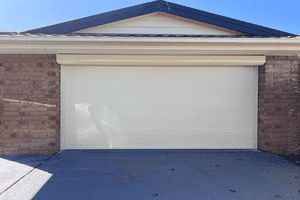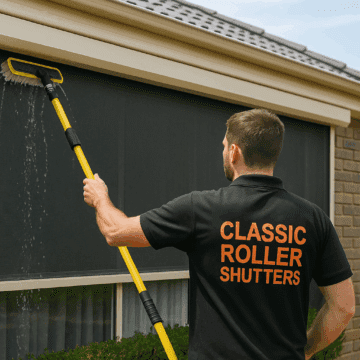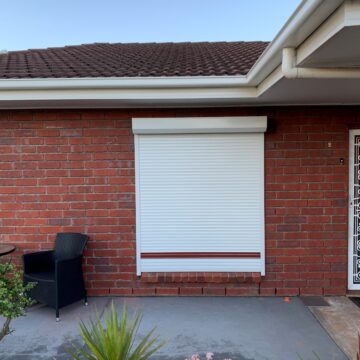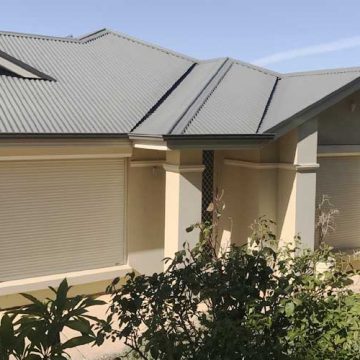A shutter roller door is a durable door made from interlocking slats that roll up into a compact drum above an opening. Chosen for high-traffic commercial and industrial sites—from warehouses and loading docks to shopfronts and car parks—it maximises security, saves space, and can be configured for airflow, visibility or fire protection.
If you’re comparing options for a new build or replacement in Australia, this guide explains the essentials in plain language. You’ll learn how shutter roller doors work, the main types and materials, the difference between a roller shutter and a roller door, and where each fits best. We’ll cover operation (manual, electric and smart), compliance and safety, sizing basics, realistic price ranges, and what drives costs. You’ll also find trusted Australian suppliers and practical buying tips, including who to call in Adelaide.
How a shutter roller door works: key components
A shutter roller door is a flexible “curtain” of interlocking slats that travels vertically within side tracks and coils around a barrel above the opening. As it opens, the curtain wraps neatly into a compact roll, saving headroom and keeping floors clear. Operation can be counterbalanced with springs for manual lift or powered by an electric motor, with controls ranging from wall switches to integrated automation.
- Curtain (slats): Interlocking steel or aluminium profiles forming the door skin.
- Bottom rail: Reinforced edge for rigidity, sealing and locking hardware.
- Side guides/tracks: Channels that keep the curtain aligned and resist wind.
- Barrel/drum and axle: The shaft the curtain wraps around to open and close.
- Endplates and bearings: Support the shaft and ensure smooth rotation.
- Drive system: Manual winder/chain hoist or electric motor with limits and override.
- Safety and seals: Safety brake, stops, weather seals; optional vision/perforated slats for airflow and visibility.
Types of shutter roller doors in Australia
Choosing the right shutter roller door starts with matching material and function to your site. In Australia you’ll see heavy‑duty steel for toughness and larger spans, lightweight aluminium for corrosion resistance and smooth operation, and specialist designs that prioritise airflow, visibility or fire protection. Below are the common categories you’ll be offered by commercial manufacturers and installers.
- Aluminium commercial shutters: Lighter, corrosion‑resistant, neat finish; popular for retail, schools and mixed‑use sites.
- Steel industrial shutters: High strength for warehouses and loading docks; suited to frequent use and wider openings.
- Fire‑rated shutter roller doors: CSIRO‑tested/approved models for fire compartmentation in compliant applications.
- Perforated/ventilated shutters: Punched or slotted slats to increase airflow and deter graffiti while maintaining security.
- Clear polycarbonate “vision” shutters: Transparent panels for shopfront visibility after hours, with robust security.
- Domestic/DIY manual shutters: Smaller spans for homes and light commercial; simple crank or winder operation.
- Oversized/industrial rolling shutters: Engineered for very large openings and parking facilities, often custom‑made to spec.
Roller shutter vs roller door: what’s the difference?
Both roll up above the opening, but they’re built and specified differently. Industry guidance is clear: roller shutters are recommended for tougher, higher‑security industrial applications, while roller doors suit light commercial and residential use. Roller doors are lightweight and easy to operate, and commonly offered in a broad range of COLORBOND colours. Shutters use interlocking slats and can be configured for airflow, visibility or fire performance.
- Curtain construction: Shutters use interlocking aluminium or steel slats; roller doors use a single continuous corrugated curtain.
- Applications: Shutters for industrial/security‑critical sites; roller doors for light commercial and residential garages.
- Large openings: Industrial rolling shutters are engineered for bigger spans and high‑use sites.
- Specialty options: Shutters offer perforated/vision slats and CSIRO‑approved fire‑rated models.
- Aesthetics: Roller doors emphasise colour choice and neat residential styling.
Commercial and industrial applications
A shutter roller door earns its keep anywhere you need secure, space‑saving access with frequent opening cycles. In commercial and industrial settings it protects stock, withstands knocks, and keeps operations moving. With options like solid steel for high‑risk sites, aluminium for corrosion resistance, perforated or clear slats for airflow and visibility, and fire‑rated models for compliance, you can match performance to purpose without compromising throughput or presentation.
- Warehouses and loading docks: High‑duty cycles, forklift clearances, impact resistance, traffic‑safe controls.
- Retail shopfronts and malls: After‑hours security with visibility; perforated or clear “vision” slats.
- Car parks and strata garages: Large openings, reliable automation, safety sensors and timers.
- Schools, hospitals and councils: Low‑maintenance security with airflow; access control integration.
- Hospitality and kiosks/servery counters: Compact coils, neat finishes, partial‑vision options.
- Manufacturing and plant rooms: Robust construction, wind resistance, fire‑rated zones where specified.
Operation and controls: manual, electric and smart options
Pick the right control method and a shutter roller door feels effortless, safe and efficient. The choice comes down to door size, duty cycle, available power and how you want people to use the opening. Smaller spans can stay manual to keep costs down, while high‑use commercial entries benefit from powered operation and smart automation. Here’s how the options stack up.
- Manual hand‑lift (spring balanced): Best for smaller/light doors; simple, low‑cost and reliable with minimal maintenance.
- Manual crank or chain hoist: Adds mechanical advantage for taller/heavier shutters where power isn’t practical; slower but robust.
- Electric powered: Mains‑powered motor with wall switch or remote; supports safety sensors, emergency manual override and auto‑close timers for busy sites.
- Smart controls and access: Add keypads, swipe/access control, scheduling and alerts; useful for car parks, retail and strata. Many existing manual units can be upgraded to electric with new controls to suit growing operational needs.
Security, airflow and visibility choices
Getting the balance right is about deciding what you want people to see, feel and reach through the opening—without compromising security. A commercial shutter roller door can be built with solid slats for maximum protection, or with perforations and clear inserts to let light and air in, showcase merchandise after hours, or ventilate car parks. Mix and match zones if you need vision at eye level and privacy above or below.
- Solid slats (steel or aluminium): Highest security and privacy; ideal for back‑of‑house, plant rooms and high‑risk sites.
- Perforated/ventilated slats: Punched profiles deliver airflow and partial visibility while deterring intrusion and graffiti.
- Clear “vision” panels: Transparent polycarbonate sections keep sightlines to shopfronts and lobbies after hours.
- Hybrid configurations: Combine solid, perforated and clear sections across the curtain to suit the opening’s use.
- Security upgrades: Heavier‑gauge slats, wind‑lock side guides, reinforced bottom rails and quality locks strengthen resistance to prying and wind load.
Sizing, spans and headroom: measurement basics
Getting measurements right ensures the shutter roller door runs smoothly and complies on site. Record the structural opening width and height, then confirm the fixing method: face‑fixed (to the wall face) or reveal/within‑jamb (between the piers). Allow for the coil above the opening, side guides and brackets, motor and safety brake, and check for obstructions like beams, services, sprinklers and signage that could clash with the coil or guides.
- Openings: Measure width and height at three points; note lintel type and substrate.
- Mounting: Face‑fix increases clearance; reveal fit preserves façade lines but needs precise tolerances.
- Clearances: Confirm headroom for the coil, sideroom for guides/brackets, and any back‑of‑lintel space.
- Site conditions: Note floor falls/ramps, kerbs, bollards, and wind exposure.
- Usage: Duty cycle, access control, and egress requirements influence motor choice and guide sizing.
Single‑piece spans vary by model. Clear “vision” roller shutters can reach up to 5.5 m wide in one section, with wider openings achieved via centre mullions. Remember: taller or heavier curtains require larger coil diameters, so headroom grows with door height and specification.
Compliance and safety in Australia: NCC, wind and fire
Compliance isn’t optional: a shutter roller door forms part of your building envelope and, in many cases, your fire and access strategy. In Australia, selection and installation should align with the National Construction Code (NCC) and your project’s certification. That means designing for wind forces at your site, choosing CSIRO‑tested fire‑rated shutters where a fire separation is required, and fitting appropriate safety devices on powered doors. Engage your builder or certifier early so the door specification, controls and signage match the approval pathway.
- Wind performance: Specify guides, wind‑locks and slat gauge to suit local wind exposure; large spans and corners typically need higher resistance.
- Fire protection: Use CSIRO‑tested/approved fire‑rated shutters only in nominated locations; they are installed per the tested configuration and typically close on alarm.
- Powered door safety: Include a safety brake, compliant controls, and suitable sensing (e.g., photo‑eyes) in public‑facing openings; provide emergency manual override.
- Egress and usage: If the shutter is on an exit path, confirm egress requirements with your certifier before finalising controls and locking.
- Documentation and servicing: Keep test data, commissioning records and maintenance logs; many approvals expect evidence of correct installation and ongoing serviceability.
Price guide in Australia: typical ranges by size and spec
Most shutter roller doors in Australia are custom-made and priced to spec, so suppliers typically quote after a site check and drawings. As a budgeting rule, total cost scales with opening size, material (steel vs aluminium), duty cycle, motorisation, wind/fire requirements and site complexity. Public price lists are rare for commercial doors, but the pointers below will help you frame a realistic budget before you tender.
- Small commercial openings (circa shopfronts/kiosks): Lightweight aluminium, manual crank or compact motor; costs influenced by finish, perforated/clear slats and lock hardware.
- Standard retail/industrial bays (warehouses, car parks): Heavier slats, wind‑rated guides and electric motors with safety brake and photo‑eyes; prices rise with width/height and controls (remotes, keypads, access control).
- Large spans and multi-bay car parks: Bigger coil/headroom, higher wind performance and duty‑rated motors; may require centre mullions for widths beyond single‑section limits (vision shutters up to 5.5 m per section).
- Specialty models: CSIRO‑approved fire‑rated shutters and clear “vision” polycarbonate curtains carry premium pricing due to tested components and compliance hardware.
- Helpful reference (windows, not doors): Residential window roller shutters commonly range about $300–$1,000 per shutter for manual units, with electric options starting from around $500; some sources cite $900–$3,000 per window installed. Commercial shutter roller doors are larger and typically exceed these figures.
Ask for itemised quotes (supply, motor/controls, electrical, safety devices, installation and disposal) so you can compare like‑for‑like and avoid surprises at approval or handover.
Cost drivers to budget for
The total price of a shutter roller door is shaped by size, specification and site conditions, not just the headline material. Think about the opening you’re securing, the performance you need (wind, visibility, fire), how often it will cycle, and what’s involved to install, power and commission it safely on your site.
- Material and gauge: Steel for toughness, aluminium for corrosion resistance; heavier slats cost more.
- Size/span and headroom: Wider/taller curtains need bigger coils, axles, guides and motors.
- Performance ratings: Higher wind resistance and CSIRO‑approved fire‑rated models add premium components.
- Curtain style: Solid, perforated or clear “vision” panels change hardware, labour and price.
- Operation and controls: Manual vs electric, duty‑rated motors, safety brakes, sensors and smart access.
- Electrical and integration: Isolators/circuits, cabling, and links to fire panels or access control.
- Installation and finishes: Face/reveal fixing, steelwork or mullions, access equipment, after‑hours work, removal/disposal, and powdercoat/colour matching.
Installation and lead times: what to expect
Because a commercial shutter roller door is made‑to‑order, delivery and install depend on your exact size, material, finish and compliance requirements. Lead times are influenced by powder‑coat colours, perforated/vision or CSIRO fire‑rated specs, factory workload, and approvals. Smooth scheduling also relies on site readiness: the opening must be built and accessible, structural fixings or mullions in place, and power/isolators available. For public or 24/7 sites, plan for after‑hours access and traffic management so installers can work safely and efficiently.
- Site measure and scope: Confirm span, fixings, wind/fire needs and access constraints.
- Shop drawings and approval: Sign‑off before production.
- Fabrication and finishing: Curtain, guides, barrel and powder‑coat.
- Pre‑wire and substrate prep: Power, isolators, angles/mullions as needed.
- Installation and setup: Mechanical fix, motor, limits and safety brake.
- Testing and commissioning: Sensors, access control, signage and handover.
Maintenance, lifespan and warranties
Commercial shutter roller doors are engineered for heavy use, but lifespan relies on correct installation and regular maintenance. Usage cycles, door size, environment (dust, coastal air) and operator behaviour all affect wear. Powered units add motors, brakes, limits and sensors that need periodic checks. Keep a service log; many certifiers and insurers expect evidence the door is safe. After impacts, isolate power and inspect.
- Clean guides and curtain: Remove grit that causes binding and wear.
- Lubricate drive components: Bearings/chain as specified; avoid spraying oils onto slats.
- Tighten and replace: Check fixings, bottom rail, locks and seals.
- Test safety systems: Safety brake, photo‑eyes/edges and manual override.
- Verify travel/limits: Smooth balance, correct stopping, no scraping.
Warranties vary; confirm coverage for curtain, motor/controls and labour, and note servicing is usually required to keep them valid.
Pros and cons versus sectional and tilt doors
When you’re weighing a shutter roller door against sectional or tilt doors, think space, duty cycle, appearance and environmental performance. Roller shutters excel in tight headrooms and high‑use industrial settings, while sectional and tilt doors often win on insulation, sealing and a softer look. Your site constraints and compliance needs will usually point to the right choice.
- Shutter roller door – best for: Compact coil and minimal backspace, large/wide openings, external mounting, security options (solid/perforated/vision), heavy duty cycles. Trade‑offs: more industrial appearance, potential noise/vibration, and generally less insulation/sealing.
- Sectional door – best for: Cleaner aesthetics, smoother/quieter operation, better sealing and thermal performance; good for showrooms and mixed‑use. Needs ceiling tracks/backspace and clear internal headroom.
- Tilt door – best for: Simple mechanism and clean ceilings on smaller openings. Requires forecourt clearance to swing, can be wind‑affected, and is less suited to high‑cycle commercial use.
Final thoughts 83692266
Choosing the right shutter roller door comes down to matching material, span and controls to your site, then layering in the performance you need—security, airflow/visibility, wind and fire compliance—at a budget that stacks up over the door’s life. Get sizes right, itemise quotes, and plan power and approvals early to avoid rework.
If you’re in Adelaide and want a straight answer on specs, pricing and lead times, talk to a local, factory‑direct team. Book a measure, send your plans, or ask about upgrades and repairs with Classic Roller Shutters Adelaide and get a solution built for your opening—not a compromise.




